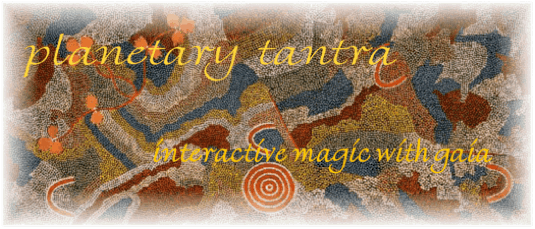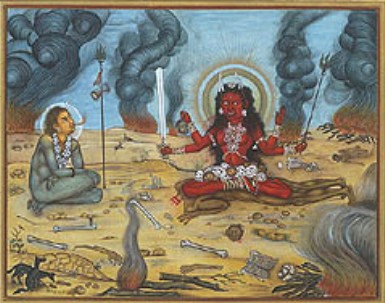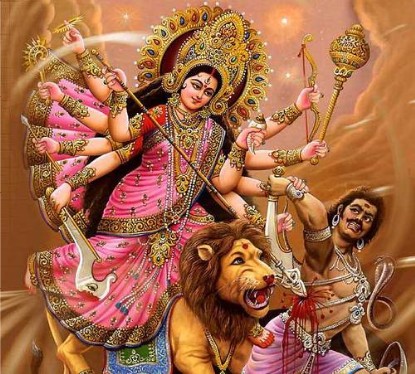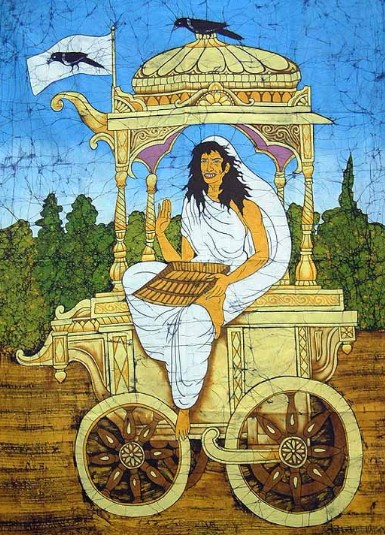| Site Guide |

LION :: Bhairavi
"The Ferocious One Who Calls to Heroism,"
attended by Dhumavati, "The Widowed Hag"
July 22, sunset crescent in the LION, with saturn - August 20, non-observable new moon in 148° ECL, conjunct Regulus the heart-star of the LION
Rather belatedly, I am posting the commentary on this shift well into the month—day 25, entering the completion phase (the last five days of any cycle). In the preceding three weeks, I have not be able to get a read on the instruction of this devata. This is the first time since I began tracking these cycles about a year ago that I have not had clear and definite impressions to report. Likewise, for those who are following the shift with me: they report on certain moods and preoccupations, but no definitive insight that might pass for instruction.
So what's happening? I can only give a few inspired guesses. But first, a look at the traits and motifs of the overseeing Mahavidya.

Bhairavi is sometimes pictured as a dakini-like witch
on the charnel ground, demonstrating the close link
between Hindu devatas the the Tibetan khandromas
derived from them.
Warrior Woman
Bhairavi means "terrible, fierce, ferocious." Think of a mother lion in rage. All the Mahavidyas exhibit extreme emotion, over the top, fitting the Kaliesque style of extremity, excess, extravagance. Bhairavi embodies divine rage in the most brutal and explicit form. She is associated with the six primary passions: "sexual lust, greed, delusion, intoxication, jealousy, anger" (Kinsley). She accentuates and favors the feminine aspect of divine force: "She is not a consort but is independent of the [male] gods and transcends them" (ibid.) Once again, we see the strong, female-only bearing of the Shakti Cluster.
Her ferocious quality exhibits "the power of destruction, including self-destructive tendencies and selfish emotions" (ibid.). I can attest to feeling a strong dose of this kind since she came on shift, but without a palpable sense of guidance or insight.

Typical Hindu kitsch: Bhairavi pictured as Durga,"she who
defeats demons,"
with lion
A variant form of Bhairavi is Kameshvari, which means "mistress (ishvari) of desire (kama)." In this aspect, Bhairavi "embodies sexual desire and the mutual attraction of the sexes" (ibid.). Again, I can attest to excessive, almost morbid obsession with these themes coming on strong at the commencement of this shift, but again, without a single clue or helpful insight on how to handle them.
Frawley says that the wrath of Bhairavi "is directed toward the impurities within us, as well as to the negative forces that may try to interfere with our spiritual growth." Since Bhairavi is associated with heat and radiance, her wrath might be compared to a fever that burns toxins from the system. We do have mental and emotional toxins in the psyche, comparable to toxins in the physical body. Is the sense of feeling sickened by what your passions, or overwhelmed by the nefarious effect of your emotional states, typical of a kind of "detox effect" with Bhairavi? I don't know. This is the first time that I have undergone this cycle consciously with the intent to detect and record the impressions that arise around instruction.
Another form of Bhairavi is Chandi, the fiercest form of the Goddess apart from Kali Ma herself. Chandi is a demon-destroying devata praised in the Devi Mahatmya, a long poem dedicated to Kali. Frawley says that she eliminates oppositions to the four goals of life: enjoyment, wealth, recognition, and liberation. I was stuck by this list, especially by the third term, recognition (Skt. dharma, meaning what you draw to you, or what tracks you, operating on the power of attraction). Throughout this shift I have had a devastating sense of living without recognition, without being seen and valued for who and what I am.
Self-Recognition
August 8 falls during the Bhairavi shift this year, as it did in 2008. On 8 August 2008, on year ago, a woman stepped off a train in Ronda, Spain and walked into the center of my life. Meeting her was the most profound experience of recognition I have ever had. Lately, reviewing that moment under the same dakini shift, I despair of having again anything close to it.
As a dualist (Mayavadin), I accept polarity as the ground dynamic of the universe, evident in the realm of the galaxies, in human affairs and gender polarity, and in the microscopic zone of mitosis and meiosis, double helices, chirality and parity. "It takes two to know one." The universe is not essentially dual but in manifesting it dynamically becomes so. In my realization, true or false as it may be, love arises with duality so that things separated can find each other. Love as a force of discovery is co-emergent with the division of the cosmos into any two aspects, this and that, witness and event, etc.
The point here being, as soon as the possibility of separation arises in the cosmos, there arises also the force that allows the separated parts to find each other. This is how recognition works in all realms of nature as well as human reality. Considered in this view, gravitational attraction between planets is a form of recognition. The starfish and the rock to which it cleaves have recognition. Bees navigating by the angle of the solar ray do so by recognition, but the solar ray and by extension the sun, also recognizes the bees. The lynx that seeks only certain animals to eat recognizes its prey, and vice versa. Likewise for human beings, lovers and victims.
Some readers will know that recognition—Sanskrit pratyabhijna, (PRAT-yah-BEEJ-nah)—is the supreme informing concept of Kashmiri Shaivism, an Asian path that parallels Planetary Tantra. Pratyabhijna ends with the root -jna, as in jnana, "spiritual insight," gnosis. Pratyabhijna is the gnosis of Self-recognition, the highest form of realization of the nature of consciousness.
Masters of Kashmiri Shaivism such as Abhinavagupta (10th C. CE) taught that the world we experience is possible because the substrate of pure bliss-filled awareness veils itself in order to generate a dyadic apparition which mirrors it back to itself. Fab, but what happens when the original witness does not recognize itself in this mirroring game or play of reflection? An endless process of self-seeking begins... Self-veiling is the opportunity for the Self apparently to lose the infinite sense of itself and yet, better still, it offers the perpetual opportunity to regain itself at every finite moment, here and now. Whenever the primary witnessing Self or foundation awareness recognizes itself, its mirrored forms are instantly "liberated." In Kashmiri Shaivism, Self-recognition is the highest mystical realization that can be attained.
To my mind, this is as cogent and elegant a description of the attainment of cosmic consciousness as can be put into plain English. But there is something to add even to this exquisite formula. At the Ronda Moment, I realized that the substrate of boundless bliss-filled awareness that produces the manifest worlds hungers after its own beauty. It perfects itself by hungering for its own exquisite reflection. In this way what is non-dual comes to share what it is dually in the real-life appearance of relationship. At that moment in Ronda I understood how the foundation awareness longs to behold its reflected self with an addictive intensity that modulates through it, infusing it with tonalities of bliss like the endlessly varied pealing of a massive choir of bells. In the massive eruptions of bliss that surge through human emotion, pleasure and pain are merely tonal variations. This does not justify or excuse the infliction of pain by one person on another. No, never. What it asserts is that any pain felt is immanently dissolved into the blissful tonality of the Self hungering for its own recognition. Such was my full-body realization at the Ronda Moment.
The primary Kalika insight adds a twist to Kashmiri Shaivism by asserting that the dynamic of addiction inheres in the primal substrate of awareness: the non-dual self is addicted to hungering for its own beauty revealed though mirroring and recognition. If this is so, love might be defined as a cosmic response of the Self to its hunger for its own beauty. Love carries the power of recognition that ultimately satisfies the need to be seen, mirrored, reciprocated.
Sexual Despair
Right now, I could not feel further away from the beauty and immensity of those superb moments of last year if I were an alien planet. From the outset, the mood of the Bhairavi shift has been one of desolation and despair. The sense of lacking recognition has been almost unbearable. Along with the sense of desolation, violent emotions arise. One long-distance ally who is following the lunar shaktis reported these impressions:
There have been some strong and troublesome emotions in the forefront: rage, craving, dejection, helplessness.
I began the shift with moods on the positive side of the spectrum, somewhat opposite to what I was expecting from the likes of Bhairavi, kind of an overlap from Vajrayogini? Despite the fact that I spotted the sunset crescent fairly early, on Day 2. But since Day 12 things have see-sawed wildly with contradictions one day to the next. Images of spiders, sharks and other predators seemed rampant where ever I looked. Weeds taking over the gardens. Particularly dreadful headline news. My ego cravings and insecurities had some pretty miserable, muddy field days.
D 16 The quote from my daily Rumi book was: "Roar, lion of the heart, and tear me open." Exactly.
D19 Horrible, bleak state of indecision.
D 20 Started fine, but then insecurity and gut-twisting hunger for connection.
21: Feeling centered. But saddened by news article about man who walked into an aerobics class and opened fire on a group of women, then killed himself....a sort of private jihad against the women he actually desires but finds unattainable? I reflected on the roots of this extreme manifestation of deviance from Gaia, as it exists in my own psyche, and how most likely it lurks well hidden in the male psyche at large.
22: Feeling of being caught in a dead end, trapped. Archontic illusions closing on me like a vise, struggling to see through it.
23: Powerful fear of abandonment, of not being seen. Boundary issue with women rears its ugly head. On the flip side, desire for dissolving all boundaries, for unity.
These impressions closely match my own, especially rage and despair over the issue of sexuality that does not provide a mirroring bliss or reciprocity. Kinsley and others emphasize the strong sexual accent of Bhairavi whose solar-leonine redness is associated with ferocious, insatiable desire. Parallel figures are the lion-headed Egyptian goddess Sekmet, and the Tibetan dakini Simhamukha who imparted sexual initiations to Padmasambhava. Last year, with the benefit of recognition, not to mention the sublime experiment of consort yoga with my Shakti, I was able to experience many positive and exalting aspects of this devata. This year, with no recognition or consort yoga, no intimate witness beside me, I find myself at the nadir of the same experience.
To make matters worse, the dismal mood of this shift appears to be complicated by the presence of another Mahavidya, Dhumavati.

The seventh Mahavidya is the smoky one, the wisdom Dhumavati.
She is tall and grim, pallid, agitated and slovenly. Her hair is tangled,
her breasts droop and her teeth are gone. Her nose is big, her body
and eyes crooked. Horrid and quarrelsome, she is perpetually tortured
by hunger and thirst. And so it is she who generates that state of
being where individuals forget their origin, lose contact with
their source, and suffer continually the agonies of unsatisfied
desire and defeated hope. This is the bottom, the nadir of creation.
Philip Rawson, The Art of Tantra
The Widow
In the initial overview of the lunar shaktis last October, I had linked Dhumavati with Vajrayogini, but that was something of a loose guess. It turned out not to fit with the Vajrayogini shift. As the moment approached for Bhairavi to come on shift, I corrected that provisional correlation. Something told me that Dhumavati was a wild card, a "floater." Studies confirmed this intuition that she did not fit into the timing of the lunar shaktis: "She is the timeless which never really enters the process of time" (Frawley). Dhumavati, "in the form of moving smoke is ever moving, never still, wanders the world, never remaining in one place for more than a few days" (Kinsley). Although all the emanations of Kali refer to time, Dhumavati does not fit into any sequential time-scheme, hence there is no constellation for her. Yet she is associated with Durga who rides on a lion, suggesting a link to Bhairavi whose locus is the constellation of the LION.
Dhumavati means "voice of smoke." She is pictured as an old hag rising on an ass or seated a lumbering cart. Her totems are the crow and the broom, Old World witch gear. Of all the Mahavidyas, she is the most unappealing and unsavory. Contrary to the desiderisitic or desire-granting penchant of the other devatas, she represents distaste for the world, social rejection, defeat, irascibility. She is the outsider of the group, the floater. She does not operate a double shift with Dhairavi, as applied with Bhuvaneshvari and Tara. She can appear at any moment in the year, but she may choose to make a distinctive gesture or disclosure during the Bhairavi shift. This, at least, is how I would understand her presence to date.
Frawley emphasizes that Dhumavati, whom he calls "the Grandmother Spirit," represents "the feminine principle devoid of the masculine principle," an accent also attached to Bhairavi. She embodies "the wisdom of forgetting," the power of the Void, the pall of smoke and ashes. In a brilliant clue, Frawley says that smoke is a screen cast over the apparent self, so that we do not suffer the death and indignity of what is not true to our existence. Ponder that one, folks.
Like those who are now following the shaktis along with me, I was extremely curious how Dhumavati would manifest, where the floater would emerge. Somehow in connection with the heroism of Bhairavi, the Widow would come into view. But how and when?
The third evening of the shift, I was sitting in a pizza parlor in the village with my companion Sabina and a local friend, Nina. Out of the blue, Nina told us a bizarre anecdote. Her uncle had died recently and unexpectedly, victim of a hospital bug when he went in for a routine operation. The uncle's wife, his widow, decided to return to a place they had lived with his ashes and commemarate their life together. Two weeks after she arrived there, she too died unexpectedly—on day 1 of the Bhairavi shift. Nina spontaneously related this story, knowing nothing at all of the Dhumavati connection.
Heroic Honesty
What to make of all this so far? This shift feels pretty gloomy all the way around. As if the presence of the Widow was dominant. Where is the heroic heart-fire of Bhairavi? So far I have yet to get a positive hit of this devata. The only shred of instruction I received was in the initial days of the cycle. It seemed to formulate itself something like this: In the past, war was the setting for heroism, because conflict between human beings requires taking a strong position, a warrior stance, but today it takes a heroic attitude just to face the human condition, just to take a stand on the way things are in human relationships.
Now, entering the last five days of the shift, I find that I can not add anything of substance to this daunting comment. I can only conclude that it may be impossible to face certain aspects of the human condition on one's own. I have suggested using the Tantric buddy-system to do the Gaian Tantra Vow. What is true for Planetary Tantra may be true for life in general: some matters can be faced and resolved better by two people together. No one alone, perhaps, can handle the rift between the sexes or the imbalance of sexual energies that marks the world today. The excess of crude sexual exposure in the media and modern lifestyles, stacked against ever-deepening frustration over genuine and honest sexual intimacy, is gruesome to contemplate, surely. Facing it alone is almost unbearable.
As the embodiment of "unsatisfied desires," Dhumavati has been taken to represent that aspect of spirituality that rejects the world and renounces its pleasures. She "is able to inculcate indifference to the world because she so unambiguously reveals the negative aspects of life." Kinsley (here cited) takes the view that Dhumavati leads to indifference toward categories of good and evil, pleasant and unpleasant, desirable and undesirable. A hard lesson, no matter how you cut it.... This is not what I would conclude from the Ronda Moment in which I realized that pain and pleasure are just equivalent intensities, polarized tonalities of bliss, but it is very close to it. Again, I must emphasize that this view does not justify or excuse the infliction of pain. It merely makes a statement about how inflicted pain is felt.
In conversation with my close friend Ria, who has been following the lunar shaktis for some months now, it came to light that the Bhairavi shift may be unique in presenting instruction through emotional states, intensities, extreme feelings, rather than in a cognitive mode. It seems as if we have been plunged into these emotional energies for the sheer experience of going through them and facing up to them, powerlessly. If this is the case, fine, but the outcome of such an exercise in futility has yet to be revealed.
Four days remain to the conclusion of this shift. Perhaps some last-minute instruction will ensue. For now all I can find of a positive bent in this shift is the resolution to total honesty in regard to non-recognition, social alienation, estrangement of the sexes, and unfulfilled desires. In The Hero - Manhood and Power, I noted that the basic moral value of salvationist religion is guilt, the sense of culpability, whereas the basic moral value in paganism was honor. Honor and honesty come from the same root. These are heroic virtues. When you are not recognized, you have to honor yourself—which has nothing to do with arrogance or pride. Even without mirroring, each one of us can honor our own experience, viewing both the positive and negative aspects with equal respect. Perhaps this is the equanimity to which we are led during the shift of Bhairavi with Dhumavati lurking on the sidelines.
Last-minute addendum: I site-reader following the cycles of dakini instruction has sent me these comments on positive impressions during this cycle:
Firstly, about Dhumavati: looking to her description, I thought that she was always with me, most of my life. I am still a university student, my family is considerably poor (a little above the deepest end) and because of financial issues, I had many many unsatisfied desires, like not being able to buy many things I wished before. This created in me an attitude of indifference towards humanly riches, a detachment from material possessions. Still I never renounced or despised pleasure. Coming to that, Dhumavati was also with me all along in the area of sexuality. Actually much of my despair and depression was about that for years.
I explained this all to show I knew Dhumavati well, so there wasn't a real difference for me during the shift to attribute to her.
Coming to Bhairavi: now this is the interesting part. Contrary to the reports of feelings in your article, this was probably my best month in the last year, or maybe even more years. Your formulation "In the past, war was the setting for heroism, because conflict between human beings requires taking a strong poistion, a warrior stance, but today it takes a heroic attitude just to face the human condition." hit the spot in me. I faced my own condition with a warrior stance, not perfect maybe, but drastically different from the rest of my life.
During one of the last days of Vajrayogini shift (July 20th) I started seeing a doctor for diet and acupuncture. I didn't like my body but I didn't do anything to get in shape also. As I was conquering my bodily laziness little by little (that week, into the Bhairavi shift, I walked a little daily. Then it got longer), I also started to get over my mental laziness: My depression seems to be ended (which was continuing for years with breaks), I started again to work on my mental faculties (to achieve concentration, clair-senses, etc.). Now I am getting in shape, bodily and mentally, also emotionally. I feel more empowered to face both my own and general human condition.
This, it seems, more like Bhairavi's positive aspects in life. Time to time I feel abandonment, loneliness, and hopelesness but those feelings are like sparks to growing camp fire of the feeling of empowerment.
Maybe it is also a meaningful connection that I am a Leo (according both to tropical and sidereal astrology), I feel connected to archetype of Leo, and Lion. This may also helped to take Bhairavi's energy positively than negatively.
So much as I remember, I hope you would have more during the completion of shift. I am yet unable to recognize more cognitive messages from shaktis, and I am looking forward to your future work.
These remarks are most helpful in putting the heavy challenge of this shift into a more inclusive, well-rounded perspective.
jll: 16 August 2009 Andalucia.
